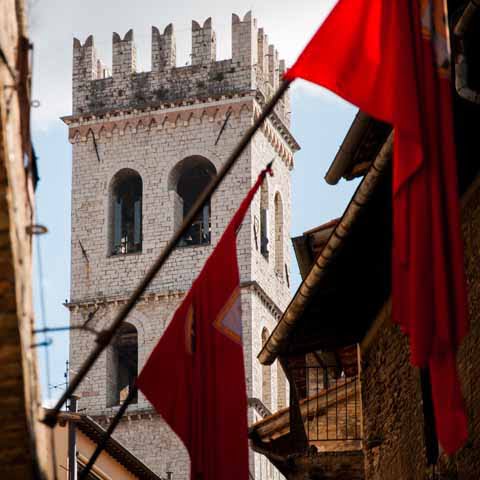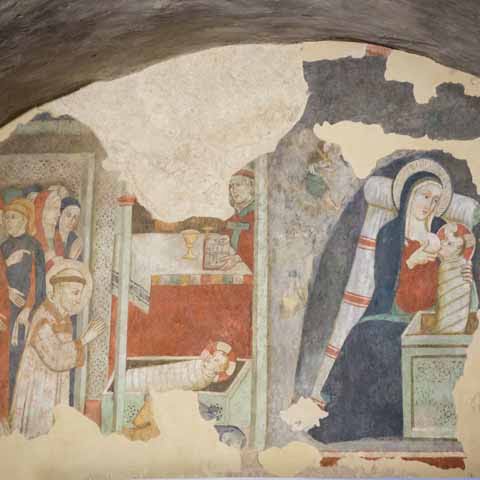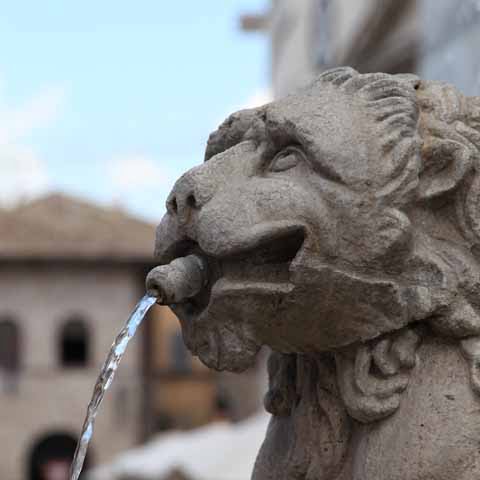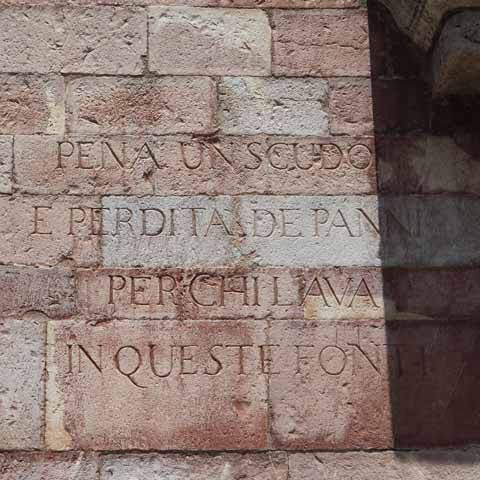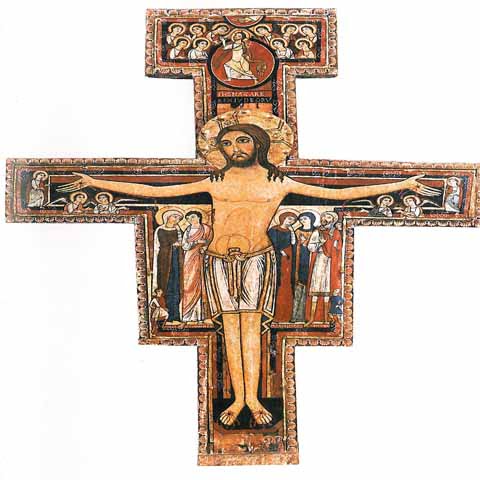A holy city for the Christian world, Assisi is a popular destination for pilgrims who want to explore the places where Saint Francis lived his entire life. Perched on the summit of Mount Subasio, this small town is one of the most important centers in Europe from a historical standpoint.
Assisi and its Franciscan sites were named a UNESCO World Heritage Site for their unique examples of medieval art and architecture. This sanctuary town has Umbrian origins and played an important role from the Middle Ages onward.
The Basilica of St. Francis is undoubtedly the center of this settlement, featuring an extraordinary architectonic complex that had an impressive influence on the development of art and architecture, not only in Umbria, but also in the rest of the country and Europe.
Assisi is also the birthplace of the Franciscan Order. The Cult of St. Francis emerged in the Middle Ages, shortly after the official canonization of the saint on July 16, 1228. Since then, it diffused throughout the world in an attempt to share a message of peace and tolerance.
Having maintained its essential role over the centuries, Assisi is undoubtedly one of the most important historical cities, not only in Italy, but in the world.
PREHISTORY OF ASSISI
Assisi has a long and rich history, tracing back to the dawn of time. The oldest evidence of human presence in the area dates back to the Neolithic Age. Numerous artifacts indicate the Umbrian origin of the settlement, and it is believed that the town evolved from a small village inhabited since the Villanovan Period, in the ninth century BC.
It is highlighted by many archaeological finds that the Umbrians had deep commercial relationships with their Etruscan neighbors, who were settled on the western bank of the Tiber River. Nevertheless, the two cultures did not share the same language or habits.
The Umbrians ruled the region for centuries, until the arrival of the Romans in 295 BC. With the Battle of Sentino, they imposed their dominion in Central Italy, Umbria included, and gave the village the name of Asisium.
Assisi became a Roman municipium in 89 BC, a fact that indicates the economic and social importance the center had in the Roman Empire.
The town became even more important during the third century, when Bishop Rufino, martyr and saint, began to spread Christianity in the region.
HISTORY OF ASSISI
With the collapse of the Roman Empire, Assisi entered into a dark age of Barbarian invasions. In 545 AD it was conquered by the Goths and then the Byzantines before passing under the dominion of the Lombards in 568 AD.
Under the Lombards, the town was annexed to the Duchy of Spoleto, and it remained a part of the Duchy until the twelfth century when, after a long period of wars, it was besieged and conquered by Federico Barbarossa in 1174.
As the new ruler, Barbarossa gave the investiture of the city to Conrad of Urslingen, the Duke of Spoleto. The town became imperial for a time, and despite internal struggles and wars with neighboring Perugia, Assisi became an important center for trade and culture.
In either 1181 or 1182, Francesco, the son of Pietro di Bernardone, a silk merchant, and Pica de Bourlemont, a French noblewoman, was born. The future saint performed extensive work and marked the history of this place and of mankind.
Certainly, Francis’ birth did not have a major influence on the history of the town at that time, and Assisi continued to deal with struggles, including the battles with Perugia, during which Saint Francis was taken prisoner. This event set him on the path to eventually found the Franciscan Order.
At the end of the twelfth century, the people of Assisi rebelled against the Duke of Spoleto, expelling him from the city. But the struggles were far from over. During the first half of the thirteenth century, the settlement suffered various Saracen attacks; at the same time, it had to deal with the incursion attempts of the great army of Frederick II of Swabia.
The imperial troops devastated the countryside on several occasions, but thanks to the valiance of its soldiers, the town resisted incursions and maintained its free statute.
Peace was hard to achieve though, as in the following years the town had to struggle with the alternating control of the Guelphs and the Ghibellines.
In the end, the Guelphs succeeded in victory, and Assisi became the dominion of the church. Then, it passed to Perugia until Gian Galeazzo Visconti managed to take control over the settlement.
However, Assisi didn’t remain under Visconti for long, and it soon passed to the House of Montefeltro before finally falling under the control of Francesco Sforza.
In November 1442, while ruled by Alessandro Sforza, Assisi was attacked by the troops of Niccolò Piccinino together with forces from Perugia. What followed were days of vain attempts to fight against the army, who eventually managed to break through the walls and enter the town. Assisi was heavily devastated; however, Piccinino opposed the complete destruction of the city despite the impressive compensation offered by Perugia to do so.
These events gave rise to new revolutionary movements, as the upper side of the town lined up with the Ghibellines against the lower side, who remained faithful to the Guelphs. The struggles between the two factions continued until the sixteenth century when the conquest of Umbria by Pope Paul III restored peace and tranquility in Assisi and the surrounding territory.
Starting with the seventeenth century, cultural activity resumed. During the century, the first cultural institutes and academies were founded, and this trend continued until the Napoleonic Wars in 1799. In fact, with the arrival of Napoleon Bonaparte, Assisi was greatly destroyed and much of its art was stolen.
Following the history of all Italian states, Assisi joined the new Italian Kingdom in 1860. This unification was prosperous for the city, which started to progressively open its gates to the outside.
Thanks to the development of infrastructure and the discovery of the bodies of Saint Francis in 1818 and Saint Clare in 1850, Assisi became one of the most important pilgrimage destinations in the world. In fact, religious tourism greatly contributed to the revival of the local economy and boosted the prestige of the city.
During World War II, following the German occupation, Assisi was inundated by refugees, Jews in particular. The town’s bishop, Monsignor Giuseppe Placido Nicolini, assisted by his secretary and the guardian of the Convent of Saint Damian, turned Assisi into one of the main centers of civilian resistance to the Holocaust.
Refugees were disguised as friars and nuns or kept hidden in the basements and cellars of the convents. Many were even provided false documents, and all Jews who sought refuge in Assisi were protected thanks to a vast network of civil solidarity that extended to many areas of Umbria and even into Tuscany.
Following World War II, Assisi continued its role as an instrument of peace. In 1986, Pope John Paul II organized a day of prayer among the heads of all major religions in the world in honor of Saint Francis. The interfaith summit initiated the “Spirit of Assisi,” an effort among religious leaders to promote peace.
In 2000, almost the entire municipal territory including the Papal Basilica of San Francesco, the Basilica of Santa Maria degli Angeli, and other Franciscan sites were declared a UNESCO World Heritage site.
In September 2007, an earthquake struck Assisi and the surrounding area, damaging the Basilica of San Francesco including part of the vault as well as frescoes by Giotto and Cimabue. Subsequently, the Basilica was closed for reconstruction work which lasted approximately two years.
Today Assisi is considered to be the top pilgrimage site in Italy, attracting crowds of faithful from around the world. The profound message of Saint Francis still resonates in the town and among its people.
ARCHAEOLOGY IN ASSISI
Assisi enjoys a rich history, and the first human traces found in Assisi, dating back to the Paleolithic era, were located in the northern side of town.
However, most artifacts do not confirm the presence of actual settlements but rather the frequent passage of nomadic populations. The presence of weapons and tools dating back to the Bronze and Iron Ages indicates, however, early colonization of the territory.
There are also traces of the prehistoric Castellieri civilization, and abundant evidence of the Roman Age.
A noteworthy site is the Roman Amphitheater, found in the Porta Perlici area. Built in the first half of the first century AD, it presents an elliptical structure and wedged travertine arches surrounding the arena.
Another interesting site is the Temple of Minerva. It dates back to the late Republican Age and was erected by two Roman consuls. Although it is called the Temple of Minerva, it has not been determined whether this temple was dedicated to Minerva or not. Despite its age, the temple impresses with an incredibly well-preserved façade that has not been altered over the centuries.
The temple has six fluted columns with Corinthian capitals resting on plinths placed directly on the stairway due to a lack of space. An underground attraction, the temple now lays under the Church of Santa Maria Sopra Minerva, which maintains the original rectangular style of the former.
But this isn’t the only noteworthy church from an archaeological standpoint. Another important edifice is the Church of Santa Maria Maggiore. Originally founded in the tenth century AD, it was the Cathedral of Assisi until 1036 when that title was transferred to the Church of San Rufino. The simple façade of this building bears an inscription divided into three sections by pilasters. The interior of the church impresses with fourteenth century frescoes, while a late medieval sarcophagus embellishes the right of the entrance.
However, the peculiarity of this church is that in its crypt, which originally belonged to a previous church or worship building – there is a passage that leads to the so-called House of Propertius. In the house, there is a cryptoporticus with several frescoes in Pompeian style and which probably belonged to a Roman dwelling. From the adjacent garden, it is possible to admire the remains of the Roman walls alongside the thick medieval one.
Indoor sites include the Roman Forum and Civic Museum, a place that contains important artifacts from the Roman and pre-Roman age, as well as medieval finds and remains.
Travel Guides
The Umbria Region of Italy
The Cities of Umbria, Italy
